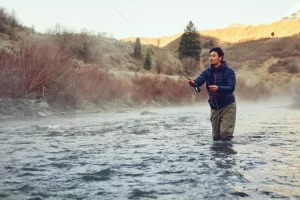Fishing in the fall or winter, especially in places like Alaska where temperatures can drop below freezing, requires the right gear and layering strategy. As the temperatures fall and the water cools, it’s essential to stay warm and dry for both safety and comfort. Here are key tips for layering to enjoy cold-weather fishing.
1. Choose the Right Layers
Effective layering starts with making sure every layer fits comfortably over the other. Tight clothing can restrict blood flow, making it harder to stay warm. Size up on jackets and waders to accommodate your layers.
It’s important to avoid cotton since it retains moisture, which can cause rapid cooling when wet. Instead, use Merino wool for base layers, fleece for midweight layers, and down for insulation. For extreme cold, synthetic down is a good option since it remains warm when wet. Invest in high-quality, waterproof outer layers to keep moisture out, and always wear a hard-shell jacket if it’s wet or windy.
2. Start with Base Layers
This is your first line of defense against the cold and should be moisture-wicking to keep sweat away from the skin. Synthetic materials such as nylon and elastane work well for warmer days, while wool or fleece is ideal for colder weather.
Smartwool’s Merino wool base layers are highly recommended for colder temperatures due to their warmth, softness, and odor-resistance. Base layers that wick sweat are critical for staying dry when moving between fishing spots or hiking to a remote lake.
3. Add Insulation
Insulation is key for maintaining warmth, especially on colder days. A hooded fleece pullover, like the Patagonia R1, works well as a midlayer for a variety of cold-weather activities. On extremely cold days, layering multiple insulation pieces is helpful.
A lightweight down jacket with a hood offers excellent warmth and protection. Consider carrying a down vest or pants for additional insulation, especially if temperatures dip significantly.

4. Outer Layers for Protection
Both your top and bottom layers should be waterproof and wind-resistant. Waders made from breathable material are great for cold-weather fishing, but if they aren’t warm enough, consider upgrading to neoprene waders. These thicker waders provide more warmth and insulation in freezing conditions.
5. Don’t Forget Accessories
Keeping extremities warm is critical for cold-weather fishing. Wear a fleece cap or insulated hat, waterproof gloves, and warm, thick socks. Insulated waterproof boots, like Xtratuff’s Legacy NXT Ice Boot, are ideal for wet, cold environments. Wool socks and toe warmers add extra warmth for long days in the water.
Layering for fall fishing is about staying warm, dry, and comfortable. By selecting the right layers and ensuring they’re breathable and waterproof, cold-weather fishing can be both enjoyable and safe. Don’t forget the small comforts like a hot drink or high-calorie snacks to maintain energy and stay warm throughout the day.
Image/Source: WOS





